
In 2024, Can Life360 Track You When Your Honor Magic 6 is off? | Dr.fone

Can Life360 Track You When Your Honor Magic 6 is off?
Did you know that your Honor Magic 6 tracks your location even when turned off? And if you’re a member of any social media network, it means you could be tracked. Do you like to have your privacy? Do you want to protect your kids from being tracked by strangers?
Of course Yes! Well, then you should know that Your Honor Magic 6 can track your movements even when switched off. But is that true?
In the event that you switch off your Honor Magic 6, the GPS function will also be disabled. As a result, it will not be able to determine your position when your Honor Magic 6 is turned off. However, Life360 will continue to provide the most recent location data that was uploaded to your account.
Should we trust Life360, the social media company that recently merged with Google, to protect our privacy? Let’s take a look at the facts.
- Part 1: What Is Life360 And How Does It Work?
- Part 2: Does life360 work if the phone is off?
- Part 3: 3 Ways to Stop Life360 from Tracking You

Part 1: What Is Life360 And How Does It Work?
The one app that kids hate and parents adore is called Life360. Life360 is monitoring software that can be downloaded into your Honor Magic 6 and used by the individuals who are part of your Family Circle to monitor your location and the location of anybody else who is part of your Family Circle.
The app works by sending a request to your cellular carrier to get your location and then sending that information to the Life360 servers. In addition, life360 will store your location and send it to your social networks automatically.
Life360 is not required to track your location, but it is required to send your location to your social networks.
If you want to know more about Life360, check out our Life360 Review.
When it comes to privacy, many people are becoming more aware of how it is being violated. As a result, there’s no need to worry about whether or not the monitoring app in concern is as trustworthy as Life360.
Disconnecting from Life360 is as simple as turning off your Honor Magic 6 and preventing the app from following and reporting your every step. Unfortunately, it also means that no one can see where they are about one another or how long it has been since they last updated their position.
If the necessity ever arose, such an undertaking may be useful for maintaining one’s privacy. However, customers have no idea that Life 360 may still be used to monitor them by other people.
Premium users will still have access to the last 30 days’ worth of location data, so the other person will be able to see where you were last seen.
Part 3: 3 Ways to Stop Life360 from Tracking You
1. Low Data Consumption
Disabling Life360’s Wi-Fi and Data may result in a warning to parents that their children are offline so that they can keep an eye on their kids. Does life 360 drain the battery? Low data mode is a better option for turning off life360 without alerting your parents. Go to the Settings and locate Life360; however, do not deactivate the exact location.

Alternatively, you should disable background app refresh, mobile network, physical activity, and WIFI to save battery life. An issue with your Internet connection will come up instead of location stopped in this situation. So don’t connect to any Wi-Fi at all.
2. Fake Locations
Using location spoofing applications on an Android smartphone, your kids can fool you into thinking they’re somewhere else. Dr.Fone - Virtual Location is a location spoofing application that will trick you into thinking that you are in a different location than you really are. The GPS position of the Honor Magic 6 device will be updated to reflect the new place that you have chosen thanks to the software. It is worth noting that Dr. Fone - Virtual Location for iOS may also enable you to imitate GPS movement.
It has several other noticeable features that can help you in your daily life.

3. Setting Wi-Fi and Data Services to “Off.”
Another typical method kids use to prevent their parents from monitoring their position is to disable Life360’s Wi-Fi and Data. It works like this. If you don’t want applications updating in the background, enable power-saving mode.
Use a wired connection. Adolescents can turn off Wi-Fi and data when using the Life360 app on an iPhone. Go to Settings, look for Life360, and disable Cellular Data, Background Refresh, and Motion & Fitness. You’ll be able to keep track of where you are on Life360.

All these methods can be used to Stop Life360 from Tracking You. However, the best all-in-one solution is a third-party application called Dr.Fone. This Virtual Location Software helps you keep your tracking off, but you can also fake your location very easily in minutes.
Conclusion
Can you track a phone if the location is off? Life360 has become a standard feature of many smartphones. Parents often use it to monitor their children’s location. The fact that Life360 can be used to track users is quite disturbing. The good news is that there are ways to stop Life360 from tracking you. The best and all-in-one solution is a third-party application called Dr.Fone - Virtual Location .
How to Stop Google Chrome from Tracking Your Location On Honor Magic 6?
Do you know your web browser is continually sharing your actual location online? You might not have noticed, but the number of websites using your location has increased. As you are well aware of the dangers of the internet, it doesn’t make sense to turn your Chrome into a beacon for ill-intentioned people. Luckily, it is possible to fake a location on Chrome with the right tool.
Are you wondering how to fake the browser location or which tool to use? You can get all your answers by reading this article till the end.

Part 1: How Does Chrome Know Your Location?
Before discussing Google Chrome’s fake location, it is important to know how Chrome detects your physical location. Google Chrome uses many ways to pinpoint your exact location, like your IP address, GPS, Wi-Fi, Bluetooth, and Cell Tower data. Every internet connection has an IP address bound to a location that enables Chrome to identify your location.
Similarly, GPS location can easily be tracked if your phone device has it enabled. All the Wi-Fi and Bluetooth connections around you also have location information embedded in them. They can help Chrome track you as long as your device can detect them. If you use cell data, Google Chrome can also track you through cell towers.
Part 2: How to Hide Location Services in Chrome?
If you are worried about Google Chrome detecting your physical location and sharing it with websites and apps, you can hide it easily. The process of hiding your location on Google Chrome is simple, even if you are using multiple devices. Below is the step-by-step process of hiding location services in Google Chrome on computer, Android, and iOS devices.
Method 1: For Laptop and Desktop PCs
Step 1: Launch Google Chrome on your computer and click the “Three Dots” icon to open the Google Chrome Settings. Here, tap “Privacy and Security” from the left sidebar and select “Site Settings.”

Step 2: Navigate to “Permissions” and click on “Location.” To hide the location on Google Chrome, select the “Don’t allow sites to see your location” option.

Method 2: For iPhone or iPad
Step 1: Navigate to “Settings” on your iPhone and open it. Scroll down until you find the “Chrome” app option and select it.

Step 2: Press “Location” on the next screen to open the location options for Google Chrome. Here, choose “Never” to stop Google Chrome from detecting your location.

Method 3: For Android
Step 1: Open Google Chrome on your Honor Magic 6, press the “Three-Dots” icon, and tap “Settings” from the options.

Step 2: In Chrome Settings, press “Site Settings.” Now select “Location” and hide your location by toggling off the “Location” option.

One way to protect your privacy and stop websites from tracking your location is to turn off the location, but it has many disadvantages. If you have turned off your location, you can’t use any location base service like food delivery, e-shopping, ride-sharing, etc. That’s why it is better to use a fake location on your browser. Below we have explained four methods for Chrome fake location.
Method 1. Best Tool to Fake Chrome Location On iOS and Android Phones
The easiest and quickest way to fake your location on Google Chrome is to use Dr.Fone - Virtual Location . Since smartphones contain a wide range of apps that require location access, it provides a stable way to fake Chrome locations on Android and iOS phones. No website or app will be able to detect that you are using a fake location when using Dr.Fone - Virtual Location for faking GPS location.
Key Features
- Dr.Fone - Virtual Location can be used for any social media app like Facebook, Twitter, or Instagram with a fake location.
- With the help of this tool, you can also spoof real-time tracking apps like Life360 to protect your privacy.
- If you are an iPhone user, you don’t have to jailbreak your iPhone to spoof your device’s location.
How to Fake Chrome Location On iOS/Android Phones via Dr.Fone - Virtual Location
Faking your Chrome location with Dr.Fone - Virtual Location is very straightforward. You only need the Dr.Fone mobile toolkit and a USB cable to connect your Honor Magic 6. Follow these steps to spoof Chrome location on Android and iOS phones:
Step 1: Connect Your Android/iOS Device to Your Computer
Connect your Android or iOS phone to your computer using a USB cable. Launch the Dr.Fone robust toolkit on your computer and select “Virtual Location.”

Step 2: Activate the Teleport Mode
Press “Get Started” on the next page to open the map window. First, select your actual location by pressing the “Center On” icon from the right sidebar. Afterward, click on the “Teleport” icon from the top right corner to activate the Teleport Mode.
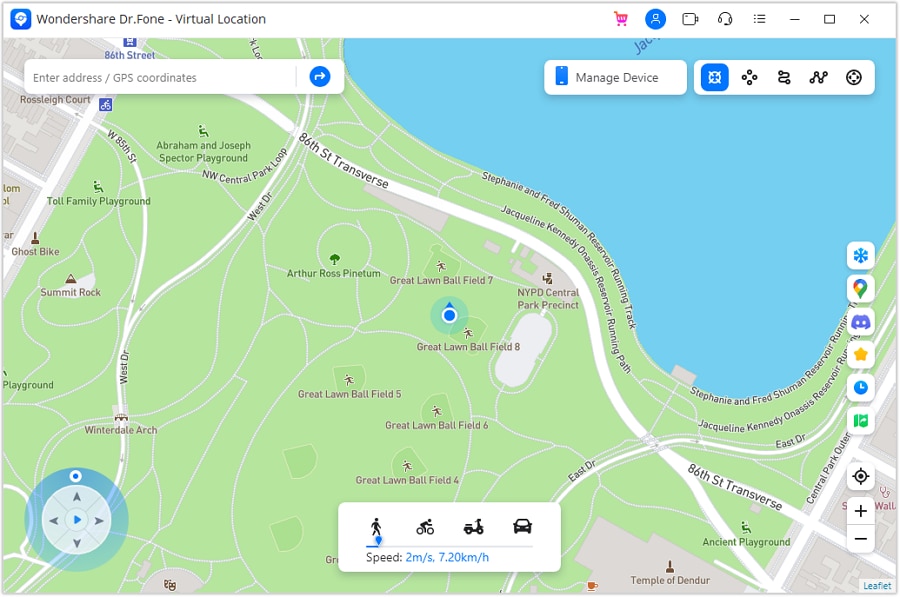
Step 3: Add the Desired Fake Location
Once the Teleport Mode is activated, add your desired location and press “Go.” Your desired location will open on the map. Select it, and a pop-up window will appear where you need to press “Move Here.” With that, your Android or iPhone’s Chrome location has been changed.
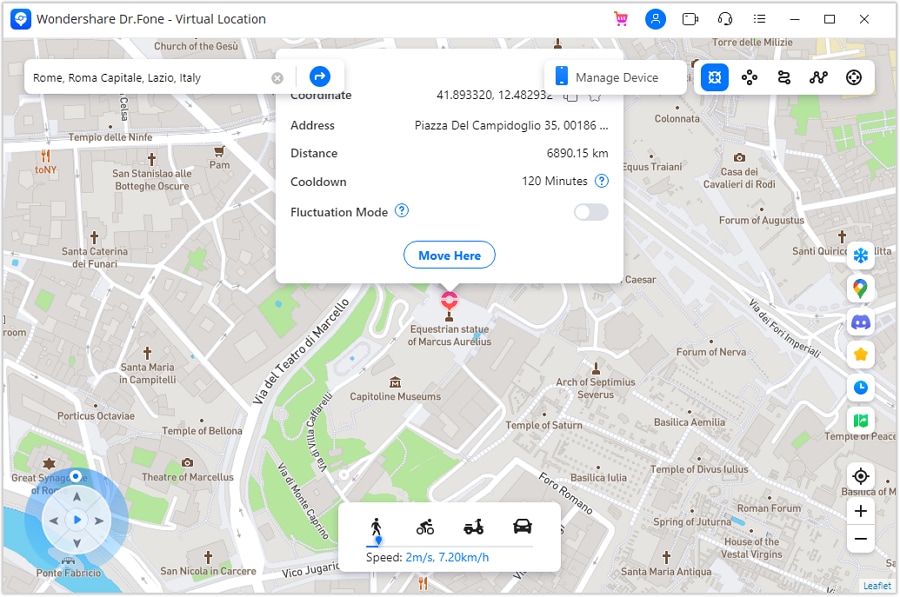
Method 2. Manually Change Your Location Using Google Chrome DevTools
It is also possible to fake browser location on Chrome using the Google Chrome Developer Tools. It is a built-in feature of Chrome and can be used to manually change or turn off your browser’s location. Follow these steps for changing location on Chrome with DevTools:
Step 1: After opening Google Chrome, click the three-dots icon from the top right corner. It will open the Chrome menu where you need to select “Developer Tools” after clicking “More Tools.”

Step 2: A window will open on the right side with all the developing tools you can use in Chrome. Click on the three-dots icon located near “Console” in the bottom left corner of the window. Choose “Sensors” from the pop-up menu.

Step 3: Access the newly selected “Sensor” option, and here you can change the browser’s location by either selecting a Google’s pre-set location or adding your desired location manually. Once the location is selected or added, your browser’s location will change.

Limitations
- The interface of the Google Chrome DevTools can be very confusing and overwhelming for non-technical users.
- Apart from pre-added locations, it can be hard to add a specific location as your fake location.
Method 3. Fake Your Location Using Chrome Extension
Many fake location Chrome extensions are available on Google Chrome which can be used to alter your location on Chrome. You can find these extensions on Google Chrome Web Store and add them directly to your browser. Below we have explained the steps for using such an extension “Location Guard “ to fake your location on Google Chrome:
Step 1: Open the “Location Guard” on Chrome Web Store and click “Add to Chrome” to add it to your browser. Once the “Location Guard” extension is added, open it and press “Options.”

Step 2: In the options, you can choose different options like Privacy Levels, Protection Area, and Time for Location Cache. It is recommended you choose a higher level for more protection.

Step 3: You can also use the “Fixed Location” feature to set up a fake location as a permanent location for your browser. The fixed location can be added by using the market or clicking on the desired place on the map.

Limitations
- Location Guard doesn’t protect your IP address. It means some websites can still detect your real location using the IP address.
- The app is not updated for quite a while, that’s why the map of the fixed location feature is quite restricted.
Method 4. Spoof Your IP Using a VPN Server
Another way you can fool websites and your browser by displaying a fake location online is to use a VPN server. VPNs fake your IP address to fool websites and apps into detecting your location. NordVPN is a VPN that can be used to spoof your IP by following these steps:
Step 1: Download and install NordVPN on your computer or phone and log in using your account. If you don’t have a NordVPN account, you must create one first.
Step 2: If you want to just change the location of your device, you can select “Quick Connect.” Using it will enable the program to automatically find the most suited fake location for you.

Step 3: You can also choose the desired location as your fake Chrome location in NordVPN. To do that, scroll down the list of countries and locations and choose your desired locations to connect to.
Limitations
- NordVPN can only spoof your IP address and will not work for geo-restricted applications.
- Using a VPN usually affects your internet speed and can make browsing slower and more difficult.
Part 4: FAQs
1.What is Geolocation?
Geolocation is a term used for the process of pinpointing the location of a device connected to the internet. The location can be determined using methods like IP address, GPS, and mobile tower data. Apps and websites commonly use it to provide location-based services.
2.What is the HTML5 Geolocation API?
The HTML5 Geolocation API is a browser API used to determine a user’s geographical location. Developers use it to build location-aware websites and apps that use users’ locations as the basis for providing their services. It can detect location through GPS, Wi-Fi, Bluetooth, IP addresses, etc.
3.Why should you hide or spoof your Location?
Hiding or spoofing your location protects your privacy and stop application and websites from tracking you. It also allows you to access geo-restricted apps and play location-based games. You can also fake your location to get the latest updates of your favorite apps.
Conclusion
The fact that Google Chrome in your devices can track your location with an accuracy of up to 20 meters is very unsettling for users. Even when you try to be careful in granting location permissions to apps and websites, many can still bypass this by adding location access requirements in terms and conditions.
That’s why having a tool like Dr.Fone - Virtual Location to fake GPS online is essential nowadays. It can ensure your privacy and helps in protecting you from the dangers of the internet.
How To Use Special Features - Virtual Location On Honor Magic 6?
Wondershare Dr.Fone - Virtual Location comes with multiple unique features that can be used to enhance the flow of spoofing location. With all these amazing features, you can easily change your iOS location without blinking an eye. Rather than making things complicated, Dr.Fone makes it easy for you to manage operations when you perform actions like changing Android locations.
Part 1: Circle Route (For Multi-Stop Route)
The circle route feature is under the multi-stop route mode. When your starting point is close to the ending point, a pop-up asks if you want to set up a circle route. Click Yes to create a circular path on the map.

Part 2: Realistic Mode (For One-Stop Route and Multi-Stop Route)
This particular feature makes the simulation look realistic with the ability to fluctuate the speed of the simulation. If you wish to turn on realistic mode for the one-stop or multi-stop route, look for the respective checkmark option in the panel on the left.

Part 3: Fluctuation Mode (For Teleport Mode)
Whenever you are teleporting your smartphone device to another location, you can try using the fluctuation mode feature offered against it. As you activate Teleport Mode from the top-right section and search for a location, you will discover the Fluctuation Mode toggle in the confirmation tab. Turn on the toggle to slightly switch the location from the selected point to show realistic motion.
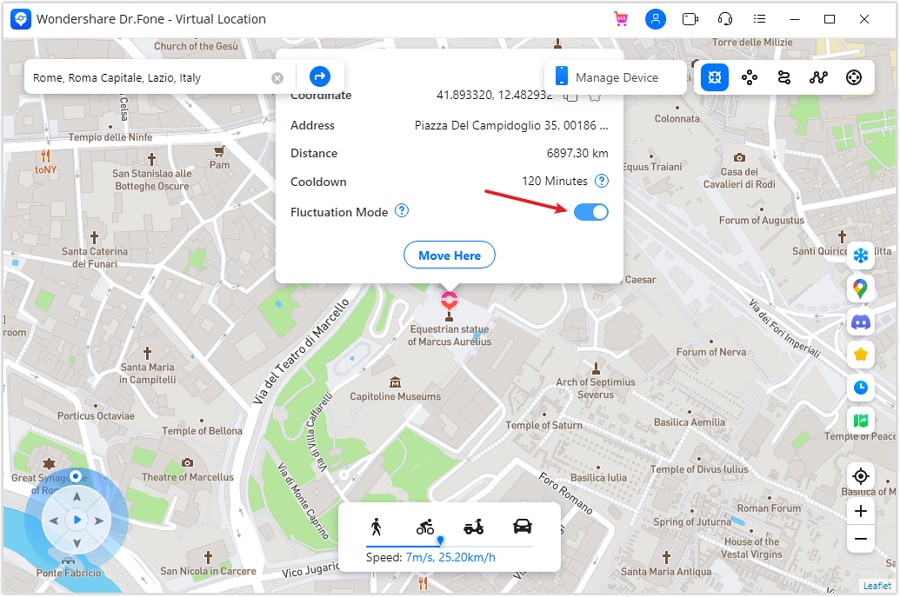
Part 4: Cooldown Timer (For Teleport Mode and Jump Teleport Mode)
While teleporting the location of your smartphone to different places for playing games like Pokemon Go, you are bound to activate a cooldown timer within your location-changing app to show realistic movement. By locating the Cooldown Timer on the right pane of icons, activate it, and this feature will automatically calculate the cooling time by measuring the distance between your destination and the starting point.

It is recommended not to start the movement until the cooldown time is completed to avoid unnecessary bans. Moreover, you can also activate the Auto jump after cooldown in the Jump teleport mode after turning on the Cooldown Timer.
This option will automatically jump you to the next destination once the timer ends. It is helpful for games like Pokemon Go, where the game servers can detect frequent jumps with no cooldown time.
Part 5: Import/Export GPX File
You can also import and export specific navigated locations from Dr.Fone in the form of GPX files. While you can export GPX files for keeping a record of your location, you can also import such files for inserting specific locations to simulate or teleport to. Find out how you can import and export GPX files with this location-changing application:
Step 1Export the GPX File
If you have defined a proper location to simulate at a particular instant using Dr.Fone - Virtual Location, you can have this location exported by clicking the Export icon on the top of the left panel. This will open a window where you can set the location for saving the GPX file.

Step 2Import a GPX File
For importing a GPX file on the platform, click the Import button on the right pane. As this opens a window, select the GPX file you wish to import to the platform.
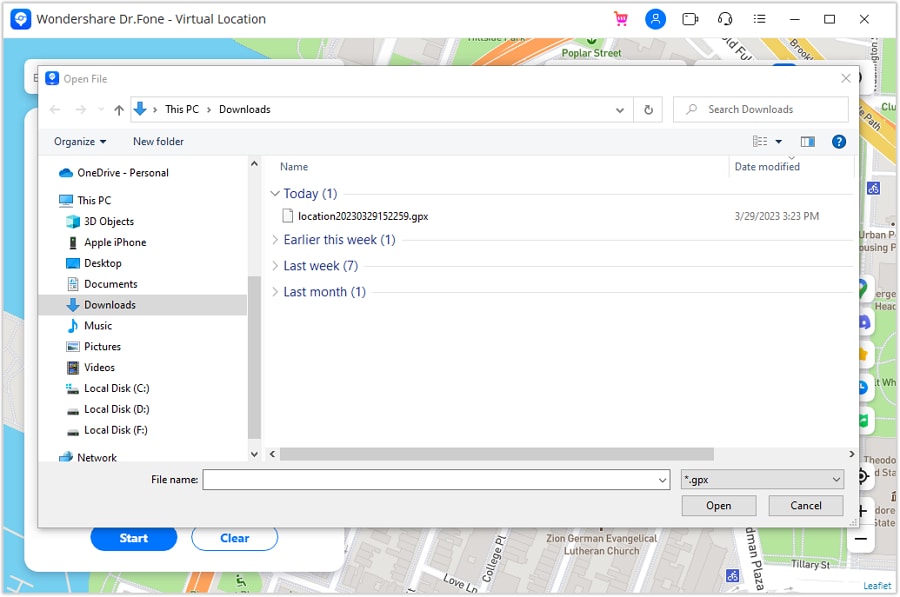
Step 3Wait for the File to be Read
Wait for a moment until Dr.Fone - Virtual Location recognizes the specific locations within the GPX file and displays them on the map.

Part 6: Historical Records
If you want to use a similar track record on your smartphone again, you can access the historical records saved on the platform for easy access.
Step 1Open Historical Records
Click the Historical Records button on the right pane to access the entire history involving the connected smartphone and the location spoofing platform.
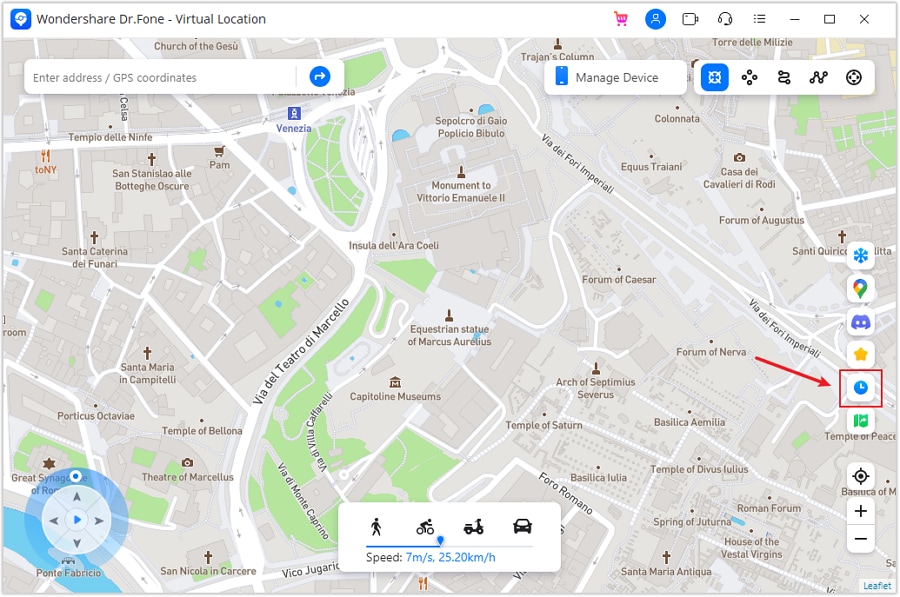
Step 2Access Any Location from the History
Select the Go button adjacent to any particular historical record to re-launch a similar simulation for the Honor Magic 6 device. You can also click Clear All to delete all historical records.

Part 7: Favorite List
You can also set up favorite locations within the platform to define quick accessibility to your favorite locations. To do that, you have to follow the guidelines shown next:
Step 1Favorite Specific Locations
While setting up locations in Jump Teleport Mode, One-Stop Route, or Multi-Stop Route, you can tap on the Favorite icon adjacent to every marked location or favorite an entire route with the Favorite icon on the top of the left panel.
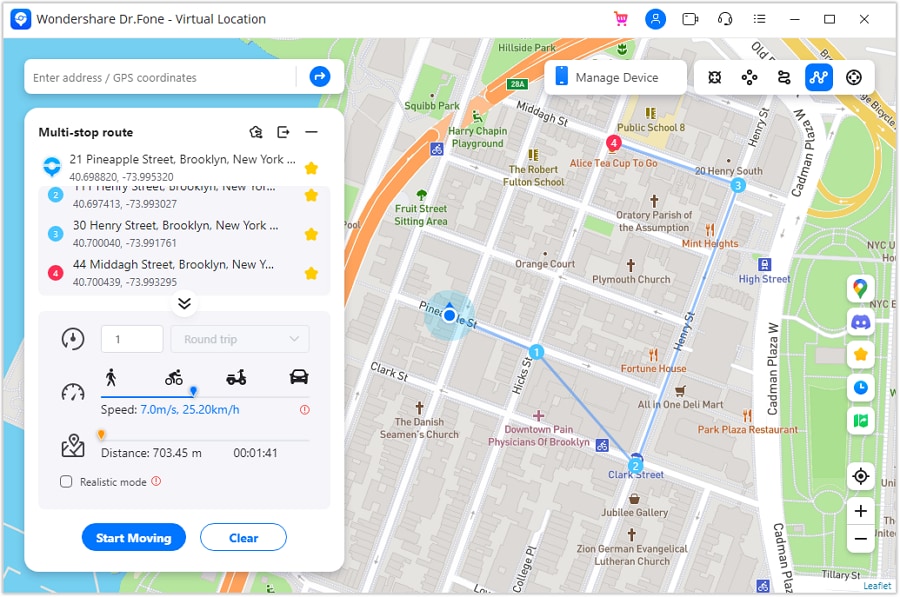
Step 2Access your Favorite Section
To look for your favorite locations, look for the Favorite icon on the right pane to open a list containing all locations you have marked. You can choose the Move option to automatically move into a particular location in no time.
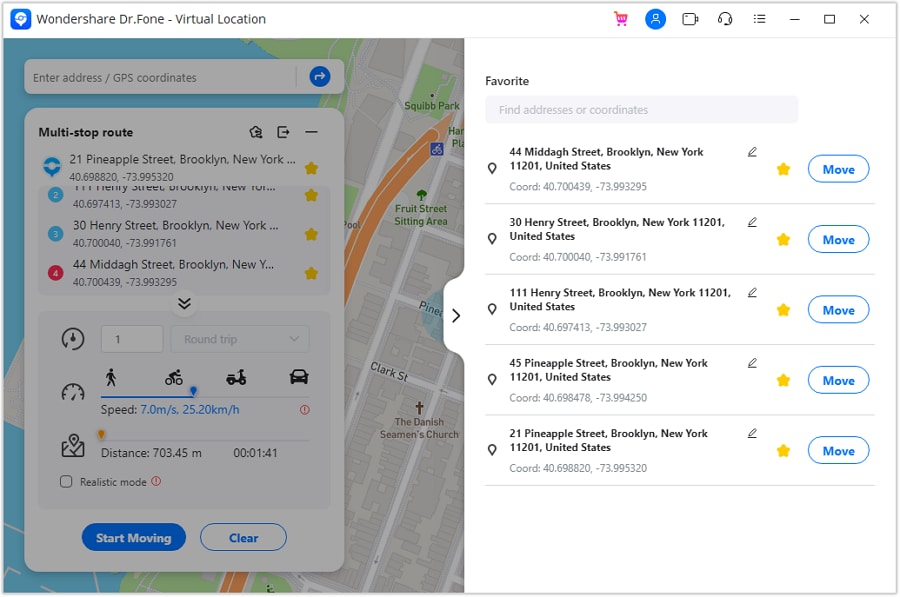
Also read:
- [New] Perfecting Presentation Adding Fonts to AE Projects
- [New] The Art of Going Viral with Instagram Stories
- [Updated] 2024 Approved BeyondShareX - Evaluating the Best Options
- [Updated] 2024 Approved Mac Studios for Top-Quality Recordings
- [Updated] Subtitled Quickly! Converting From Compressed Files
- Catch or Beat Sleeping Snorlax on Pokemon Go For Xiaomi Redmi A2 | Dr.fone
- How to identify malfunctioning your hardware drivers with Windows Device Manager on Windows 10 & 7
- In 2024, 9 Mind-Blowing Tricks to Hatch Eggs in Pokemon Go Without Walking On Samsung Galaxy A14 5G | Dr.fone
- In 2024, Can I use iTools gpx file to catch the rare Pokemon On Vivo Y200e 5G | Dr.fone
- In 2024, Pokemon Go No GPS Signal? Heres Every Possible Solution On Samsung Galaxy S23 Ultra | Dr.fone
- In 2024, Ultimate guide to get the meltan box pokemon go For Vivo Y200 | Dr.fone
- Mastering Android Device Manager The Ultimate Guide to Unlocking Your Vivo V27 Pro Device
- Troubleshooting and Fixing Monster Hunting Disconnections on PC
- Unleash Power Play with Budget-Friendly ASUS ROG Ally at Only $400
- Title: In 2024, Can Life360 Track You When Your Honor Magic 6 is off? | Dr.fone
- Author: Nova
- Created at : 2024-12-12 22:16:45
- Updated at : 2024-12-17 18:31:45
- Link: https://change-location.techidaily.com/in-2024-can-life360-track-you-when-your-honor-magic-6-is-off-drfone-by-drfone-virtual-android/
- License: This work is licensed under CC BY-NC-SA 4.0.

